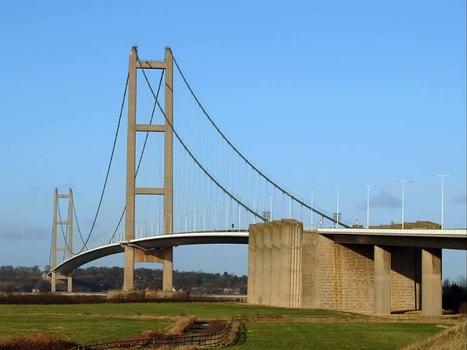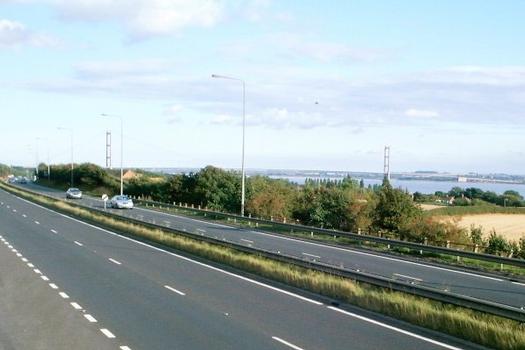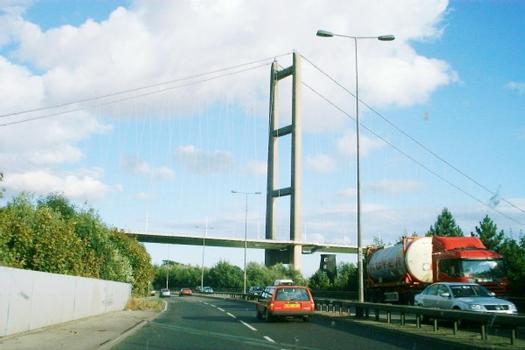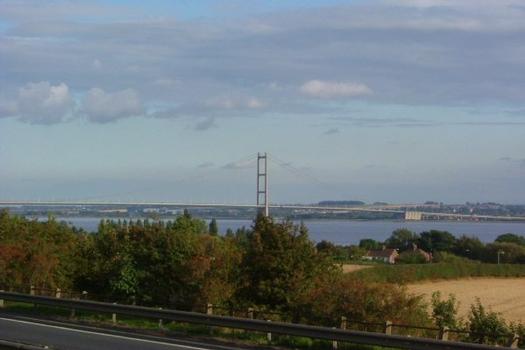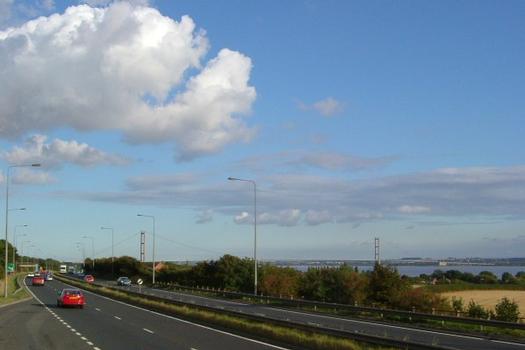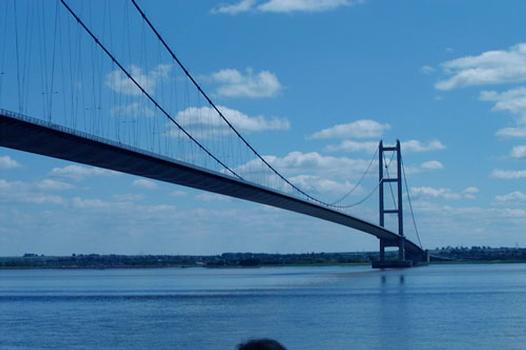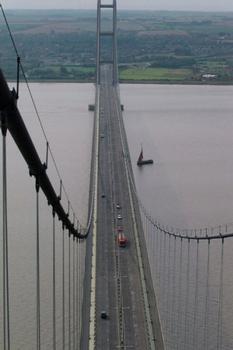General Information
Project Type
| Structure: |
Suspension bridge with diagonal hangers |
|---|---|
| Function / usage: |
Motorway bridge / freeway bridge |
| Material: |
Steel bridge |
| Construction method: |
Structurae Plus/Pro - Subscribe Now! |
Awards and Distinctions
| 2017 |
for registered users |
|---|
Location
| Location: |
Kingston upon Hull, East Riding of Yorkshire, Yorkshire and the Humber, England, United Kingdom |
|---|---|
| Crosses: |
|
| Coordinates: | 53° 43' 7.35" N 0° 27' 3.82" W |
| Coordinates: | 53° 41' 32.29" N 0° 27' 0.46" W |
Technical Information
Dimensions
| main span | 1 410 m | |
| total length | 2 220 m | |
| span lengths | 280 m - 1410 m - 530 m | |
| number of spans | 3 | |
| cables | number of cables | 2 |
| strands per cable | 37 | |
| wires per strand | 404 | |
| weight | 11 000 t | |
| wire diameter | 5 mm | |
| on-axis distance between cables at top of towers | 22.200 m | |
| deck | width | 28.500 m |
| deck depth | 4.500 m | |
| number of lanes | 2 x 2 | |
| roadway / carriageway width | 2 x 7.300 m | |
| walkway width | 2 x 3.000 m | |
| suspenders | wire diameter | 62 mm |
| towers | height | 155.50 m |
Quantities
| concrete weight | 480 000 t |
Materials
| cables |
steel wire
|
|---|---|
| deck |
steel
|
| suspenders |
steel wire
|
| towers |
reinforced concrete
|
Chronology
| 1959 | Passing of the Humber Bridge Act |
|---|---|
| July 1972 | Work begins on the south approaches |
| March 1973 | Work begins on the substructure |
| April 1973 | Work begins on the superstructure |
| May 1974 | North tower completed |
| July 1976 | Completion of south tower |
|
September 1977
— July 1979 |
Cable spinning |
| October 1979 | First box section of the superstructure is erected |
| July 1980 | Closing of the superstructure |
| 24 June 1981 | First traffic passes over the bridge |
| 17 July 1981 | Officially opened by Queen Elizabeth II |
| 1992 | Installation of a dehumidification system for the cable saddles and the main girder. |
Notes
The cable carrying the shorter side span has 800 more wires than the rest of the bridge.
Humber Bridge Tourist Information Centre
North Bank Viewing Area, Ferriby Road, Hessle HU13 OLN.
Tel: (01482) 640 852
Excerpt from Wikipedia
The Humber Bridge, near Kingston upon Hull, East Riding of Yorkshire, England, is a 2.22-kilometre (2,430 yd; 7,300 ft; 1.38 mi) single-span road suspension bridge, which opened to traffic on 24 June 1981. When it opened, the bridge was the longest of its type in the world; it was not surpassed until 1998, with the completion of the Akashi Kaikyō Bridge, and is now the tenth-longest. It spans the Humber (an estuary formed by the rivers Trent and Ouse), between Barton-upon-Humber on the south bank and Hessle on the north bank, thereby connecting the East Riding of Yorkshire and North Lincolnshire. Both sides of the bridge were in the non-metropolitan county of Humberside until its dissolution in 1996. The bridge can be seen for miles around and from as far as Patrington in the East Riding of Yorkshire and out to sea miles off the coast. It is a Grade I listed building.
By 2006, the bridge carried an average of 120,000 vehicles per week. The toll was £3.00 each way for cars (higher for commercial vehicles), which made it the most expensive toll crossing in the United Kingdom. In April 2012, the toll was halved to £1.50 each way after the UK government deferred £150 million from the bridge's outstanding debt.
History
Before the bridge opening, commuters would go from one bank to the other either by using the Humber Ferry that ran between Corporation Pier at Hull and New Holland Pier at New Holland, Lincolnshire or by driving via the M62 (from 1976), M18 (from 1979) and M180 motorways, crossing the River Ouse near Goole (connected to the Humber) in the process. Until the mid-1970s, the route south was via the single-carriageway A63 and the A614 (via grid-locked Thorne where it met the busy A18 and crossed the Stainforth and Keadby Canal at a swing bridge bottleneck, and then on through Finningley and Bawtry, meeting the east-west A631).
The journey was a series of straight single-carriageway roads across foggy moors interrupted by predictable bottlenecks for most of the journey to Blyth, Nottinghamshire, where it met the A1. The accident rate was consequently high, and the journey of most of Hull's traffic was similar to that faced by much of Lincolnshire's drivers today. Debates in Parliament were held on the low standard of the windy route across the wind-swept plains around Goole. It was not unexpected that under these conditions, a Humber Bridge, with connecting dual-carriageway approach roads, and grade-separated junctions, would seem worthwhile. By the time the bridge opened, much of this well-below-standard route had been transformed by dualling of the A63 and its bypasses, the extension of the M62, and the much-needed connecting of the M18 from Thorne to Wadworth. The obvious need for a Humber Bridge had largely been tempered by the late 1970s with the much-improved motorway infrastructure of the region. Although welcome, the timing of these improvements would detract any significant levels of traffic needing to cross a bridge from Hessle to Barton. The Humber Bridge would be a victim of the M62's success, before opening.
There was also a short-lived hovercraft service; Minerva and Mercury linked Hull Pier and Grimsby Docks from February to October 1969, but suffered frequent mechanical failures.
Act of Parliament
Plans for a bridge were originally drawn up in the 1930s, and were revised in 1955, but work did not begin until 27 July 1972. The Humber Bridge Act, promoted by Kingston Upon Hull Corporation, was passed in 1959. This established the Humber Bridge Board to manage and raise funds to build the bridge and buy the land required for the approach roads.
1966 Hull North by-election
However, raising the necessary funding proved impossible until the 1966 Hull North by-election. To save his government, Labour Prime Minister Harold Wilson prevailed upon his Minister of Transport Barbara Castle to sanction the building of the bridge. Dismay at the long wait for a crossing led to the writing by Christopher Rowe of a protest song entitled "The Humber Bridge".
Design
The consulting engineers for the project were Freeman Fox & Partners – now Arcadis NV. Sir Ralph Freeman had produced the first ideas in 1927, and in the early 1930s the cost of the project was thought to be around £1.725 million, and that the bridge would be unlikely to recoup the construction or maintenance costs. In 1935 he had an idea for a 4,500-foot (1,400 m) suspension bridge for the Humber Tunnel Executive Committee. Sir Gilbert Roberts produced more ideas in 1955 for a bridge with a 4,500-foot (1,400 m) central span, costing £15 million, to be paid for by East Riding County Council and Lindsey County Council. Once it was looking likely that a bridge would be constructed, Imperial College-educated Bernard Wex OBE (24 April 1922 – 31 July 1990) produced the design in 1964 that was actually built. At the time of construction, it was built to last 120 years. In 1985 he was awarded the Telford Medal by the Institution of Civil Engineers. In the 1950s he had helped to design High Marnham Power Station. He was a former UK chairman of the International Association of Bridge and Structural Engineers, and helped to found the Steel Construction Institute in 1976.
The architect was R.E. Slater ARIBA. The administration building (for the tolls) was designed by Parker & Rosner. The landscaping was designed by Prof Arnold Weddle. Wind tunnel testing took place at the National Maritime Institute (now part of BMT Limited) at Teddington in the London Borough of Richmond upon Thames, and the road deck is designed for wind speeds up to 105 miles per hour (170 km/h).
Construction
The main contractor for the steel superstructure was British Bridge Builders (the same grouping as for the Forth and Severn Road Bridges comprising Sir William Arrol & Co., then a unit of NEI Cranes Ltd, the Cleveland Bridge & Engineering and Redpath Dorman Long Ltd). The contractor for the concrete towers, anchorages and sub-structure was John Howard & Co Ltd of Chatham, Kent, who were later bought by Amec. Concrete was chosen for the towers, instead of steel, partly due to cost but also to fit the surrounding landscape.
Work began on the southern approach road in July 1972 by Clugston Construction of Scunthorpe. The 2.5 km (1.6 mi) approach road to the A1077 junction, by Costain Civil Engineering began in September 1976. It included a 320 m (1,050 ft) span from the southern anchorage of seven pre-stressed concrete box sections, and the A1077 junction, costing £4.25 million. Work on the bridge substructure (foundations) began in March 1973. To reduce heat of hydration in the concrete, which produces calcium silicate hydrate from belite, as much as 60% of the Portland cement was replaced with ground granulated blast-furnace slag (GGBS). It took longer to build the southern anchorage due to a diaphragm wall design due to not enough shallow bedrock. The main southern approach roads from Barton to the M180 motorway junction at Barnetby were built in the late 1970s by Clugston Construction of Scunthorpe, opening in 1978.
The towers were constructed by slipforming, and the north tower was completed by May 1974. The southern foundations were completed in September 1975, with the pier completed in March 1976, and the southern tower was completed by September 1976. The bridge itself had been planned to open in 1976. The northern tower and anchorage was built on solid chalk, but the southern tower and anchorage were built on fissured Kimmeridge Clay, and 500 metres from the southern shore, and built with a difficult caisson design. The subcontractor for the concrete was Tileman & Co. of Shipston-on-Stour, south Warwickshire.
Cable spinning took place between September 1977 and July 1979. Each cable weighs 5,500 t (6,100 tons), with 37 strands of 404 lengths of cable. The cable on the northern span has four extra strands. Each cable can take a load of 19,400 t (21,400 tons). The deck is of box girder form. The box sections weighed around 140 t (150 tons) each. The first box sections were assembled in June 1975, and put into the main span on 9 November 1979. The toll buildings and north approach road were built by A. F. Budge of Retford, Nottinghamshire, costing £2.9 million. Work began on the administration building in November 1976. The toll system was manufactured by Plessey Controls of Poole, Dorset. Corrosion resistance on the steelwork was provided by Camrex Corrosion of Bellshill, North Lanarkshire.
The road was laid by Tarmac Roadstone of Wolverhampton with mastic asphalt.
In 2017, the bridge was designated a Grade I listed building.
Opening
The bridge opened to traffic on 24 June 1981. It was opened officially by Her Majesty, Queen Elizabeth II on 17 July 1981 a ceremony which included a prayer of dedication by the Archbishop of York and a fly-past by the Red Arrows.
World record
With a centre span of 1,410 metres (4,626 ft) and a total length of 2,220 metres (7,283 ft), the Humber Bridge was the longest single-span suspension bridge in the world for 17 years, until Japan's Akashi Kaikyō Bridge opened on 5 April 1998. The road-distance between Hull and Grimsby was reduced by nearly 50 miles (80 km) as a consequence of the bridge.
Bridge statistics
The bridge's surface takes the form of a dual carriageway with a lower-level foot and cyclepath on both sides. There is a permanent 50 mph (80 km/h) speed limit on the full length of the bridge.
Each tower consists of a pair of hollow vertical concrete columns, each 155.5 m (510 ft) tall and tapering from 6 m (20 ft) square at the base to 4.5 m × 4.75 m (14.8 ft × 15.6 ft) at the top. The bridge is designed to tolerate constant motion and bends more than 3 m (10 ft) in winds of 80 mph (129 km/h). The towers, although both vertical, are 36 mm (1.4 inches) farther apart at the top than the bottom due to the curvature of the earth. The total length of the suspension cable is 71,000 km (44,000 miles). The north tower is on the bank, and has foundations down to 8 m (26 ft). The south tower is in the water, and descends to 36 m (118 ft) as a consequence of the shifting sandbanks that make up the estuary.
The bridge held the record for the world's longest single-span suspension bridge for 16 years from its opening in July 1981, until the opening of the Great Belt Bridge in June 1997, and was relegated to third place with the opening of the Akashi Kaikyō Bridge in April 1998. It is now the eighth longest single-span suspension bridge. The central span, at 1410 m (4640 ft), is the UK's longest. It remains the longest single-span suspension bridge in the world that one can cross on foot or by bicycle. The bridge is crossed twice during the annual Humber Bridge in June half marathon and Hull Marathon in September.
Toll update project
In July 2013, work began on introducing a new electronic tolling system. The existing Humber Bridge toll system was largely the same as it was when the bridge opened in 1981, and used a computer system that was over 15 years old. This obsolete technology required an increasing amount of maintenance and needed replacing. The project to update the tolls and the resulting decrease in waiting times was welcomed by business and transport leaders.
Phase one of the project focused on updating the infrastructure and saw all the toll booths replaced as well as the toll plaza canopy. Phase two concentrated on writing, testing, and setting up the new toll system. The project completed in 2015 allowing bridge users to set up an account with the bridge and pay into it. Account holders receive a device called the HumberTAG, a small electronic tag that enables the system to recognise the bridge user and the toll is automatically deducted from the user's account. The two central lanes through the plaza are free-flow lanes: they do not have any booths and account holders are able to cross the bridge without stopping.
Incidents and suicides
During construction of the bridge, the road deck sections were floated up on barges then hoisted into place by cables. During one of these lifting operations some of the cables on one of the road deck sections failed, leaving the section hanging at an angle. The section was, however, subsequently rescued and used.
More than 200 incidents of people jumping or falling from the bridge have taken place since it was opened in 1981; only five have survived. Between 1990 and February 2001 the Humber Rescue Team launched its boat 64 times to deal with people falling or jumping off the bridge. Notable incidents include the cases of a West Yorkshire woman and her two-year-old daughter who fell off the bridge in 2005, and that of a man jumping from the bridge to his death on the A63 road below in September 2006.
As a result, plans were announced on 26 December 2009 to construct a suicide barrier along the walkways of the bridge; design constraints were cited as the reason for non-implementation before this time.
In May 2017, a YouTuber with the username 'Night Scape', along with a small group, illegally scaled the bridge without safety equipment. The group of young men climbed up the structure to the top of the bridge whilst using the suspension wires as handholds. Humberside Police and the Humber Bridge Board are reviewing the security measures.
Finances
The bridge has a toll charge of £1.50 for cars[ when?]. Until 1 April 2012 the Humber Bridge was the only major toll bridge in the United Kingdom to charge tolls to motorcycles (£1.20); others such as the Severn crossings and the Dartford Crossing are free. In 2004, a large number of motorcyclists held a slow-pay protest, taking off gloves and helmets and paying the toll in large denomination bank notes. Police reported a tailback of 4 miles (6 km) as a consequence of the protest.
In 1996, the British Parliament passed the Humber Bridge (Debts) Act 1996 to reorganise the Humber Bridge Board's debts to ensure the bridge could be safely maintained. Although a significant proportion of the debt was suspended in that refinancing arrangement there was no "write off" of debt and the suspended portion is being gradually re-activated as the Bridge Board pays off the remainder of the active debt.
In 2006 a Private Member's Bill – sponsored by Cleethorpes Labour MP Shona McIsaac – relating to the Humber Bridge, was introduced into Parliament. The Humber Bridge Bill would have made amendments to the Humber Bridge Act 1959 "requiring the secretary of state to give directions to members of the Humber Bridge Board regarding healthcare and to review the possibility of facilitating journeys across the Humber Bridge in relation to healthcare". The aim was to allow people who travel from the southbank to the northbank for medical treatment to cross the bridge without paying the toll, and to allow the Secretary of State for Transport to appoint two members of the Humber Bridge board to represent the interests of the NHS. Even though the Bill received cross-party support (it was co-sponsored by Shadow Home Secretary David Davis, and supported by all other MPs representing North Lincolnshire and the East Riding of Yorkshire) it ran out of time later that year.
A protest at the bridge on 1 September 2007 was supported by the local Cancer Patients Involvement Group, the Road Haulage Association, Yorkshire and Humberside MEP Diana Wallis and local business and council representatives. The government responded to the petition on 14 January 2008, stating that "Concessions or exemptions from tolls on the Humber Bridge are a matter for the Humber Bridge Board."
In October 2008, a joint campaign was launched by the Scunthorpe Telegraph, Hull Daily Mail and Grimsby Telegraph to abolish the fee for crossing the Humber. The papers' A Toll Too Far campaign garnered much support from councillors and MPs serving Lincolnshire and Humberside and was launched in response to a mooted increase in the cost of bridge crossings. The campaign's aim was not only to stave off any potential increase in crossing charges, but to ultimately see the costs abolished. A reduction to a £1 charge for bridge crossings was a sought-after alternative. Thousands of readers backed the campaign with a paper and an online petition.
A public inquiry into the tolls was held in March 2009 by independent inspector Neil Taylor. In July 2009, the Department for Transport announced that it had decided not to allow the proposed increase. Transport Minister Sadiq Khan said he did not believe it was right for the tolls to be raised in the current economic climate. In October 2009, the government approved a £6 million grant for maintenance costs, which meant that there would be no toll increase before 2011 at the earliest, by which time tolls would have been frozen for five years.
The Humber Bridge Board applied again to the Department of Transport in September 2010, to raise the tolls from April 2011, but the Government ordered a public inquiry to be held into the application. A three-day public inquiry was held in Hull in early March 2011. Following the recommendation by the planning inspector the Government gave approval, on 14 June 2011, for the increase to go ahead. The toll was raised on 1 October 2011, at which point it became the most expensive toll crossing in the United Kingdom. The Severn Bridge and Second Severn Crossing charge a toll of £5.70, but this is only collected in one direction.
In the 2011 Autumn Statement on 29 November, the Chancellor of the Exchequer, George Osborne, announced that the Government had agreed to reduce the debt on the bridge by £150 million, which would allow the toll for cars to be halved to £1.50. Following the government accepting the agreement, between the four local councils, to underwrite the remaining debt Transport Secretary Justine Greening confirmed the reduction in tolls on 29 February 2012. This was implemented in April.
Text imported from Wikipedia article "Humber Bridge" and modified on July 22, 2019 according to the CC-BY-SA 4.0 International license.
Participants
- C. Douglas Strachan (resident engineer)
-
Freeman Fox & Partners
- Bernard Wex (designer)
- Bill Harvey (engineer)
- John Howard and Co. Ltd. (foundations)
- Sir William Arrol & Co.
- Cleveland Bridge & Engineering Co. Ltd. (superstructure)
- John Thompson Ltd. (superstructure)
- Redpath Dorman Long Ltd. (superstructure)
Relevant Web Sites
Relevant Publications
- (2016): A-frame rocker bearing replacement at Humber Bridge, UK. In: Proceedings of the Institution of Civil Engineers - Civil Engineering, v. 169, n. 3 (August 2016), pp. 113-120.
- (1987): Ambient Vibration Measurements of the Humber Suspension Bridge and Comparison with Calculated Characteristics. In: Proceedings of the Institution of Civil Engineers, v. 83, n. 3 (September 1987), pp. 561-600.
- (2010): Ambient vibration re-testing and operational modal analysis of the Humber Bridge. In: Engineering Structures, v. 32, n. 8 (August 2010), pp. 2003-2018.
- (1997): L'architecture et les ingénieurs. Deux siècles de réalisations. Moniteur, Paris (France), pp. 147.
- (1993): Bridges. Macmillan Publishing Company, New York (USA), pp. 148-149.
- About this
data sheet - Structure-ID
20000290 - Published on:
21/05/1999 - Last updated on:
21/04/2016

